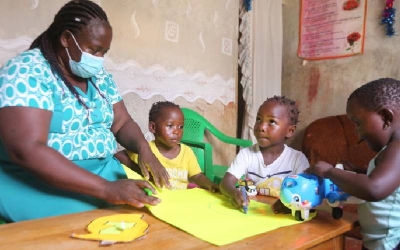
Education
RE-IMAGINING DUAL APPRENTICESHIP SYSTEM:
10 February 2022
A promising Solution for Spurring TVET Graduate Employment in KenyaI recently had a conversation with one of the leading plumbing company executive, who revealed interesting insights on the quality of TVET graduates. Much as he seemed to appreciate the high quality of theoretical learning taking place at TVET institutions, he asserted that most graduates are experiencing significant challenges in aligning to changing labour market needs due to lack of exposure on current technologies, industry trends and requisite 21st century social and soft skills.Nonetheless, it is important to note that the Government and TVET stakeholders have put a lot of effort to change this trajectory, in various ways, these includes; the implementation of the Competency-based Education and Training (CBET) curriculum, increased communication and advocacy on vocational training, and increased attention to Industry and academia linkages. Such legislated and established policies and initiatives are helping to address this and other gaps.As has been documented elsewhere, Kenya is experiencing a “Youth Bulge” with over 20.1% of its population aged between 15 and 24 years. The same is reported in most sub-Saharan Africa countries with growth averaging at 19.7%, while the rest of the world is at 16.2%. Statistics also indicate that Kenyans between the ages of 15-34 years account for 84% of the unemployed population. Essentially this means, there is a high youth unemployment rate in Kenya which is bound to increase due to the prolonged economic impacts of the Covid- 19 pandemic. Despite these unemployment statistics, young people continue to leave school to join the unemployed cadre even as the potential of selfemployment through TVET is ignored.Notably, an additional 5 million youth will be entering the labour market by 2025 making the situation dire. As such more effort is needed to improve the quality of learning in the TVETs and to smoothen…
PARTNERSHIP-BASED PLATFORM TO SUPPORT TRAINING OF TEACHERS AND PRINCIPALS
15 December 2021
The creativity and resiliency of teachers is one of the reasons that the Kenya Women Teachers Association is proud of the teaching fraternity in Kenya.Our teachers do more than just teach. Students often form bonds with teachers and rely on this trust to ask for advice and guidance, especially during times of personal or communal crisis. As has been demonstrated during the Covid-19 pandemic, our teaching fraternity has scored highly both in and out of the classroomBoth teachers and students have experienced isolation, uncertainty, grief, and loss during this time. And as the government through the Ministry of Education and the Ministry of Health work with other education stakeholders in recovering learning loss and keeping our schools open, we stand in solidarity with teachers in the quest for safer and healthier working conditions.Championing the welfare of teachers, KEWOTA continues to play its role in empowering our teachers by giving them a voice, continually calling for safe spaces where teachers can work to develop our children is at the top of our goal.A few critical issues jump out regarding teacher preparedness as our schools grapple with the health challenge. For instance, despite the ongoing national roll-out of the vaccination exercise, we are cognizant of the fact that children under the age of 12 years cannot be vaccinated. In light of the impending fourth wave of infections, we urge for continuous discussions regarding the health protocols around teachers and staff who are more engaged with this age group in both primary schools and early childhood educationEnsuring all teachers get their double vaccination doses is imperative but above all we must maintain the health and safety of all teaching and non-teaching staff and environments. To make school environments safe, additional health and hygiene measures should be implemented.In Nairobi’s primary schools for example, the…
WHY WE SHOULD GIVE CBC A CHANCE
15 December 2021
Furore about the competency based curriculum, with the divisive factor being, its shortcomings and expected outcomes. From the hue and cry it seems that parents with children in private schools are bearing the brunt of the systems shortcomings. Complaints abound about how demanding and expensive the curriculum is, particularly, on parent’s time and financial resources.And it’s not just parents who are unhappy; it appears teachers are also unhappy. The immediate former Secretary General of KNUT, Hon. Wilson Sossion’s was recently quoted saying that CBC is a fraudulent system that threatens to reverse the education gains the country has made. Professor Lukoye Atwoli, on the other hand had this to say, “CBC will create a bigger gulf between the have and have not’s.” At the height of this debate the President of the Law Society of Kenya, Mr. Nelson Havi decided to move to court to save parents from what he termed as, ‘the CBC burden’. The government on the other hand has stood its ground, with the education CS saying that CBC is going nowhere, it is here to stay. . It is almost impossible not to sympathize with ‘CBC parents’, who are bearing most of the financial burden, or with the teachers, who are ill prepared for the momentous challenge of delivering this new curriculum, or with academicians, like Prof. Lukoye who have had an opportunity to interrogate this subject in detail. To be very honest each and all, have a pointBut if we were to look at it from a different perspective, in line very much with Prof. Lukoye’s thinking. One realizes that this simmering crisis has indeed given us the perfect opportunity to review CBC. We have with us the ideal occasion, timely in every respect, to review and interrogate the progress this system has made since…
LEADING EDUCATION INSTITUTIONS IN UNCERTAIN TIMES
15 December 2021
Since the 2008 financial crisis, academicians, experts and analysts have been studying the effects of disruptions to economies and businesses, world over. A lot of research and writings since then have led to various models which can help leaders prepare, predict and cope with emergent disruptions. However, 2020 saw a global, almost apocalyptic disruption affect the entire planet. Global education systems were disrupted in a way that only West Africans could comprehend – for they had experienced a similar large-scale disruption during the 2013-2016, Ebola epidemic.Back here in Kenya, the on-going curriculum reforms has given education policy makers and education institution leaders, a chance to re-imagine how to provide for educational access, equity, quality and sustainability in uncertain times. During the pandemic, school and institution leaders have become more important than ever. The pandemic has provided education leaders with a global snapshot of the effect a large scale disruption can have on the entire education spectrum. So, what implications does this current context have for leaders (new and old) as they prepare to lead in uncertain times?For most leaders managing education institutions in Kenya, the pandemic has forced them to look to the business world to understand the crisis and find quick turn-around solutions. J. McGregor & A. Harris (2006) posits that the start of ‘...the new century [...] has been characterized by calls for a greater understanding of the processes of knowledge creation and the transfer of practice.’ Yet it took the global shut-down of education systems to make school leaders seek out new knowledge that would help them adapt, and help them redesign their schools for learners. School leaders were forced out of their insular, inward-looking models to embrace collaboration, even us they looked to the business world to help them solve problems and improve their adaptive capabilities.…
Unpacking Competency Based Curriculum (CBC)
15 December 2021
Traditional educational approaches have been more concerned with the transmission of knowledge and skills than with the introduction of values and attitudes, or, in other words, with the holistic upbringing of learners “competent for life”. However, already by the end of the 20th century it became clear that education should have a more relevant role in fostering achievement of individuals’ aims and also social and economic welfare. All these created the breeding ground for the emergence of the concept of “competence”. However, for the time being, there is not a unique, distinct definition of “competence”, which makes it scarcely operative and hinders application in educational planning. In this context, competence is being used non-uniformly, and often as a mere declaration of intent, and this is creating ambiguity regarding the design of competence based learning.The onset of the 21st century, coincident with the turn of the millennium, meant a turning point in several areas: education, environment, and economic development among others. Education, thus, appears as central to personal and community development; its mission is to enable learners, without exception, to develop their talents to the full and to realize their creative potential, including responsibility for their own lives and achievement of each individual’s personal aims, but also involvement in one’s social roles at work and in the community.McClelland defined the term competency as, “a sum of knowledge, skills, and aptitudes, which contributes to the capacity of a person to effectively perform the duties and responsibilities of the occupied job; in other words, to be competent”. In this concept, we could look at competencies in three perspectives:Behavioural approach: Competence as a set of abilities that ensure productivity in the labour market. In this approach, with roots in the United States, competences are understood as a demonstration of behavior; i.e., the traits that…
INDUSTRY-ACADEMIA LINKAGES OR LEAKAGES? TIME TO RESURFACE THE LONG-STANDING DEBATE
07 December 2021
A conversation with Dennis, a graphic design and an advertising expert, along with other testimonials from graduates, got me wondering if we are experiencing Industry-Academia linkages or leakages. Like other graduates, Dennis was very optimistic when he joined one of the leading universities in Kenya to study graphic design and advertising. The orientation in the first year inspired him more, and he could easily see a bright future ahead. The theoretical work offered in school was excellent; however, he feels that there are limited opportunities for practicing what is taught in school. He emphasizes that the three months’ industrial attachment does not guarantee that one is ready for the job market. He adds that at times, the tasks one takes during the attachment are not fulfilling as they may not be in line with the student’s career. He asserts that he has obtained most of his graphic design and advertising skills from YouTube and constantly advances them for a competitive advantage in the continuously changing job market. After graduation, he applied for formal employment with no success since most organizations avoid hiring fresh graduates. The situation is saddening and mirrors many other graduates floundering with joblessness due to lack of work experience and opportunity to transition after their education and training pursuits; Industry-Academia leakages are likely to overpower the linkages unless appropriate actions are taken. If there are potent linkages, organizations could compete for fresh graduates to obtain new knowledge and innovativeness. Covid-19 has worsened the situation.Every demographic has had its own share of Covid-19 pandemic effects. However, among all the demographics, the youth have been vastly affected despite their low infection rates. For instance, the lockdown measures have led to the rescheduling of their training and education, job losses, and mental health and emotional challenges due to the health…
TOWARDS A GLOBALLY COMPETITIVE QUALIFICATION SYSTEM IN KENYA
07 December 2021
Examining the Role of Kenya National Qualifications Authority (KNQA)Development of National Qualifications Frameworks (NQFs) has become a world-wide phenomenon and continues to draw international interest not least in Sub-Saharan Africa, where Kenya has become a trail blazer in the effort to enhance quality and relevance of its education and training sector. The reasons for adoption and implementation of NQFs are many and varied. Most of the countries that have adopted a NQF are concerned with the poor articulation between qualifications and actual skills needs in the workplace; need to rectify the poor credibility and quality of existing qualifications and training programmes and lack of coherence and the rather fragmented nature of the qualifications system. The need for provision for recognition of non-formally acquired skills and facilitating integration of such skills into the formal system - where a large part of the population is evidently excluded from the formal education system or where there is a high number of school dropouts also creates an impetus for adoption of National Qualification Framework. The Frameworks, thus provide a basis for improving the quality, accessibility, linkages and labour market recognition of qualifications within a country and internationally.Quality Education and Training is as vital as the dissemination of the supposed education itself at all levels. A country whose education and training standards are below par, results to poor values in its work force and lack of the required expertise. Every Educational and Training system or institution for that matter, requires an efficient and proper outline of quality assurance systems that guard the productivity, relevance and clarity in formulating and actualizing the stipulated missions, visions, goals and objectives. This should be in line with the country’s goals as well as the global goals of education and training. When Quality Assurance organs function well, the training bodies…
THE STEADFAST CHAMPION OF WOMEN IN EDUCATION - BENTA OPANDE
07 December 2021
The Editor had the pleasure of meeting Ms. Benta Opande, Chief Executive Officer of the Kenya Women Teachers Association - KEWOTA. A warm and amiable person, her story is one of passion, bravery and resilience. “I think realizing that you’re not alone, that you are standing with millions of your sisters around the world is vital.” – Malala Yuafzai. So this quote by Yuafzai is befitting and resonates very well with her journey from the classroom to CEO, of the largest Women Association in Kenya.Ms Benta Opande is a teacher by profession, trained at Kenya Science Teachers Training College, KSTC. A career that started 35 years ago, she remembers fondly her first posting in 1989 to Parklands Boys Secondary School, where she began by teaching Chemistry, Biology and Sports. But it is in teaching sports where her passion for inspiring people to excel and push the limits was born, and was solidified when she became the first female coach of the school hockey team. She recalls that when she started coaching the boys, the team was performing poorly but soon after, the performance began to improve, and by the time she left, the team had gained recognition and was winning accolades in the National sports arena. It had become the team to beat. This impressive performance enabled her to get her next posting to Buru Buru Girls High School, where in addition to Hockey, she introduced Basketball. However, sports remained pretty much extracurricular activity, with her main responsibility being teaching biology and chemistry. This went on for some time until her excellence in managing the Buru Buru girls’ sports department was recognized when her fellow teachers in Nairobi elected her as an executive committee member of the Nairobi Secondary Sports Association.From Blackboard and Chalk to AdvocacyAs she grew in her…
IMPROVING QUALITY BASIC EDUCATION THROUGH DIGITAL INTELLIGENT LEARNING GAMES
07 December 2021
Within the past two decades, the proliferation of technology has changed the face of both Kenyan education and Kenyan workplaces. The ability to effectively use a computer and a smart phone has become as fundamental to a person’s academic and occupational success as reading, writing and arithmetic. These rapid changes in technology have also put the current learning and teaching system under huge pressure to adapt. The stellar performance of learners using educational games suggests significant importance of providing children with access to computers to enable them to learn adequate computer skills and enhance their educational experience (Trotter, 1998). As computers become a staple in each home, the number of homes with digital devices has significantly increased in the last 5 years with children, between the age of 2-18, having access to them. We have intelligent learning games currently driving the 3Rs; Reading, Writing and Arithmetic in class and at home. Learning game companies such as d-school World of Learning have revolutionized education in Kenya. The learning games have transformed learning and teaching of mathematics, reading, Science, character development and critical thinking lessons into adventures for all learners! In each of the class-based programs, students are invited to embark on a journey through the play World – a personalized 3D environment that knows and grows with your child. Along the way, students master dozens of skills based on world class educational standards.Designed by educators and built with cutting edge interactive play technology, such games are powerful supplemental learning solutions that every classroom needs.Key Features of such solutions include: -• Learning curriculum designed by educators and aligned with state standards• Classroom management system allows each teacher to organize their classroom and easily view progress by student or class.• Personalized learning system unlocks new lands and challenges according to each student’s progress•…
TACKLING UNIVERSITY FUNDING IN KENYA: INTERVIEW WITH CEO GEOFFREY MONARI
26 November 2021
1. HOW HAS YOUR EXPERIENCE SHAPED YOU INTO THE LEADER YOU ARE TODAY?Professionally, I have been in the higher education sector for 23 years, this is my 24th year. I started as a humble Accounts Clerk and I worked my way up to become the Chief Operations Officer (COO) of the Higher Education Loans Board (HELB). At HELB, I began honing my leadership skills by leading small teams and I grew over time to manage bigger teams. I found joy inspiring my teams to meet targets and day to day challenges. As my responsibilities grew, I attended various training programs that opened my mind on how to lead and manage people. Reading widely also helped me upscale my leadership skills. And by the time I became COO I had learnt new ways to inspire and motivate my 120 members of staff, to pursue a vision that would drive the institution to achieve beyond its core mandate, which included; lending, loan recoveries and documentation.2. YOU ARE NOW 9 MONTHS OLD AT THE HELM OF THE UNIVERSITIES FUND, HOW HAS THE TRANSITION BEEN FOR YOU?When I joined in December 2020, the Fund had not been operationalized and was minimally resourced. I took over an institution with only one employee, who happened to be the acting CEO, the Fund occupied 3 rooms at Teleposta Towers and the budget was only 24 million. However, in 9 months I have been able to lobby and our budget has been increased from 24million to 244million. With the support of the Cabinet Secretary, the Fund was allocated more spacious offices in the NACOSTI building where we currently are. Within this same period we have managed to come up with a revised Differentiated Unit Cost (DUC). And we are currently undertaking public private participation for the university funding…
© Copyright 2025 EdSource Africa by BIL















